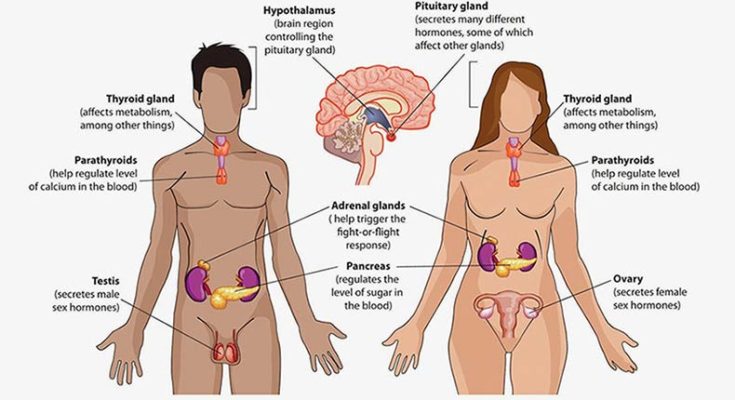Exocrine and Endocrine Glands of human body which lead a major role in balancing almost all the functions of a human body and ultimately the ageing process. Image Courtesy – https://socratic.org
In our second article, we discussed how the joints get affected as we grow older. In this session, we will discuss the Exocrine and Endocrine Glands of the human body which lead a major role in balancing almost all the functions of the human body.
Various types of organic chemicals come out from these glands, which are called Hormones. Hormones control various organic functions of the human body starting from the time of birth till death. Some of the glands become inactive within some time span after birth. The glands which have duct with them are called Exocrine Glands, and the glands which do not have any duct are called Endocrine Glands. Generally, Hormones are called to those bio-chemicals which come out from Endocrine Glands.
Names of the prime glands of the human body are given below:
(i) Pineal Body, (ii) Pituitary Gland or Hypophysis, (iii) Thyroid, (iv) Para-Thyroid, (v) Thymus, (vi) Adrenal, (vii) Pancreas, (viii) Gonads & Overy, (ix) Testicle and (x) Kidney.
The quantity of Hormone secretion from these Endocrine Glands is very low, but still, these bio-chemicals take an effective role in various functions of the human body. Some of the secretions help in digestion, some other secretions like thyroxine help in metabolism and preserving temperature in the human body.
Hormones also control heartbeat, blood pressure, activeness of muscular fiber, etc. The activeness of the Nervous System help in gland secretion, on the other hand, gland secretions help in maintaining the activeness of the Nervous System. The pituitary is the main gland that controls other Endocrine Glands.
Read: Delaying ageing process in the human body – Part II
One of the other glands is the Pineal Gland, also known as the Pineal Body, Conarium, or Epiphysis Cerebri. This is a small endocrine gland that produces melatonin hormone, which controls the modulation of sleep patterns in both seasonal and circadian rhythms.
The saints of the ancient age invented the art of yoga at that time because they felt that a human being afflicted by various diseases is unable to put his/her concentration on the contemplation of God. We can remember the famous Sanskrit phrase, “Sharirmadhyam Khalu Dharmasadhanam” – meaning “the body is the mode of fulfillment of dharma”. So our ancient sages started several Yogas and Mudras for maintaining physical fitness and to keep a safe distance from disease. They also showed us the way to delay the ageing process.
Yoga has enormous effects on the nervous system, various glands, and other organs of the human body. ‘Sirsasana’ has the capability of sending huge blood to the brain and maintaining it healthy and more active. Yoga like ‘Sarvangasana’ and ‘Matsyasana’ activate Endocrine Glands like Thyroid and Parathyroid by sending huge flow blood into them.
Thus, by practicing regularly of this art of Yoga, the capability of the brain increases, the nervous system remains active and muscles of the body remain strong. Some long-lasting diseases like Constipation, Diabetes, Piles or Hemorrhoids, Watery Semen, etc. can be cured by practicing yoga regularly and in a systematic manner. We will discuss various yoga postures and their effects on the human body in the next part.





